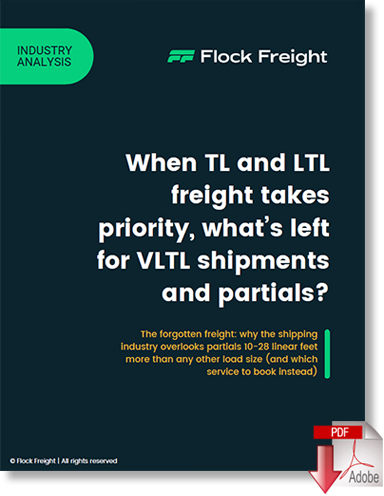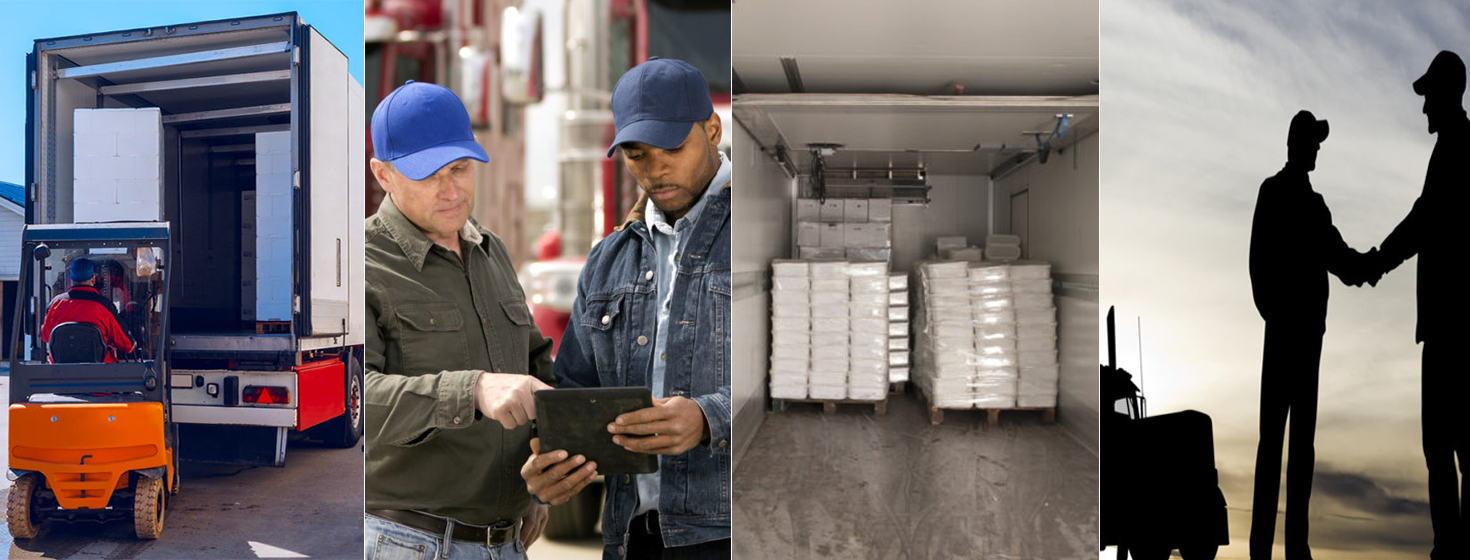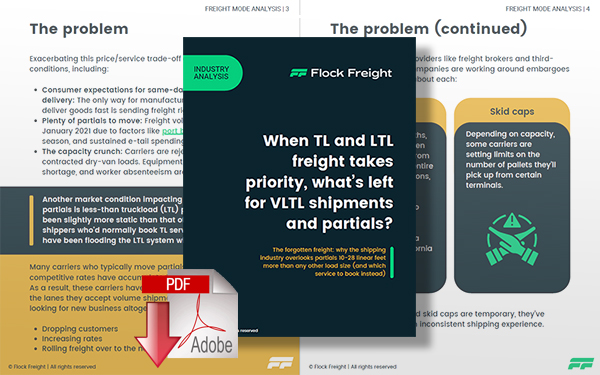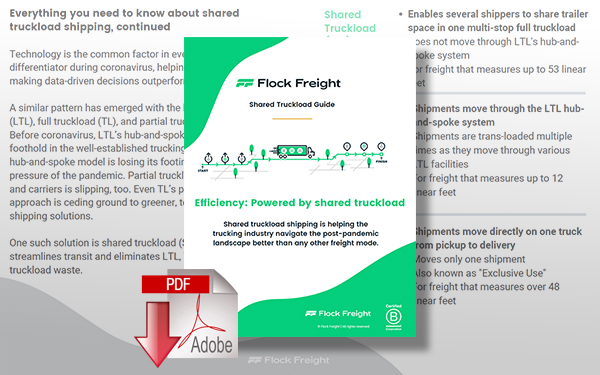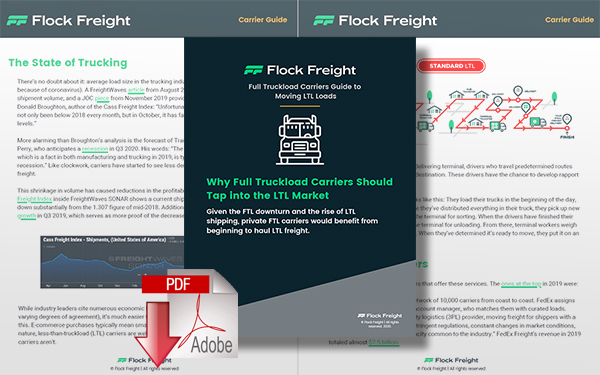Biggest Pain of Shipping Freight between 10-28 Linear Feet

Learn to recognize the challenges of midsize freight transportation so you can move your goods with ease.
All Well With Your Supply Chain?
Today, you are shipping several high-value goods by volume less-than-truckload (VLTL), which will be arriving safely and on time … or so you think.
The truck carrying your freight stops at a terminal to add additional shipments to the load, shifting and repositioning your goods. A few hundred miles later and your load transfers to another truck. With each transfer, your fragile goods load and unload until they incur damage beyond repair. Now you must make up for the substantial cost of someone else’s mistake.
Your freight reaches its destination two days late, and a final fee arrives for you in the mail with the steep price of your shipment. Only now can you see the additional fees from layovers and reweighs. Back to the drawing board; how can anyone possibly ship 10-28 linear feet of freight without the entire process turning into such a pain?
What Do Shippers Want?
When it comes to moving freight, the goal is simple: effective and efficient transportation. However, the process of choosing a mode of freight transportation can become complicated when weighing the pros and cons of various systems.
Traditionally, shippers looking to move 10-28 linear feet of freight have two main options: volume-less than truckload and partial truckload (PTL).
More often than not, consumer expectations soar far above the capabilities of VLTL and PTL. Shippers want cost savings, zero damage, fast transit, simple tracking, and an exceptional level of service. Partial and volume LTL shipping cater to some, but not all, of these needs. The result: inefficient transportation of goods and unhappy customers.
What Are Partial Truckload and Volume Less-Than-Truckload?
Partial truckload - When a shipment is too big for less-than-truckload (LTL) but too small for full truckload (TL) service, partials provide another option for midsize freight. They come into play when shippers don’t want to pay for unused truck space they can’t fill but exceed the size constraints of traditional LTL service.
Unlike LTL and VLTL shipments, partial rates are based on cost per mile and don’t require a freight class.
Additionally, partials tend to move from point A to point B on the same truck, eliminating much of the loading, unloading, and damage that can occur with LTL shipments.
Volume less-than-truckload - Volume LTL shipments follow a similar outline, larger than LTL, but too small for TL. More specifically, the size of VLTL shipments falls between LTL and truckload freight.
Traveling through the hub-and-spoke system, volume LTL shipments often make multiple stops to transfer goods from truck to truck.
The Pitfalls of Partial Truckload
Slow-moving service - Partials travel through consolidation facilities, which means extra stops and added time.
Initiating a partial load can be a slow process as freight moves through consolidators (usually asset-light, regional carriers). The driver of a partial shipment will generally wait until the entire trailer is filled before starting on its route.
If you’re looking for quick, easy, and accessible service, partials may not be the best option for you.
The Pitfalls of Volume LTL Service
The unreliable hub-and-spoke system - Volume LTL shipments have a high rate of handling, which means more damaged freight. Like LTL freight shipments, VLTL shipments run through the hub-and-spoke system. When shipments travel via this system, they unload and load with other freight.
A truck may stop at multiple terminals, which means your goods relocate onto several trailers before arriving at their final destination. This slows transit time, increases loading and unloading, and, ultimately, creates a higher risk of damaged freight.
Slow-moving freight - As mentioned above, VLTL shipments run through a network of terminals, which significantly increases the amount of time it takes a shipment to move from point A to point B.
On top of this added time, delivery of VLTL shipments is generally contingent upon the freight carrier’s capacity at the time, based on their backhaul availability.
Speed and efficiency are key to effective freight transportation. Often lacking in both, VLTL is not the most reliable option if you’re looking for a swift and dynamic mode of delivery.
Complicated Freight Classification System
Volume LTL trucking uses a freight classification system to determine pricing and freight quotes. The system, which the National Motor Freight Traffic Association (NMFTA) provides, identifies factors like ease of handling, value, weight, length, height, density, and liability. Unfortunately, a system meant to simplify freight delivery rates often overcomplicates them.
Shippers must identify the right NMFC number (a number that establishes the carrier’s freight cost) and calculate the freight class accurately to ensure correct billing.
As a result, inaccurate NMFC calculations are a common occurrence for shippers who don’t have the time or resources to attend NMFC freight calculation webinars or to research their classification.
More often than not, shippers are not aware of overcharging on freight-shipping rates until after the fact.
Limited Liability
Another pitfall of volume LTL freight shipping is that it has very low liability when compared to other forms of trucking.
The liability limit for VLTL is no more than $1 per pound, compared to LTL shipping, which is generally between $5-$25 per pound. A damaged, high-value item without additional insurance will likely cause the shipper to take a major financial hit.
For example, VLTL service would only cover $1,000 of a damaged item weighing 1,000 pounds and worth $10,000. That’s a loss of $9,000. If you plan on shipping fragile or high-cost goods and prefer making money to losing it, you may want to consider other trucking options.
Sneaky Accessorial Charges
Accessorial charges are fees due to additional services the freight carrier may provide. The charges don’t show up until after the load delivers, which means shippers don’t know the true pricing when booking their shipments.
Some examples of these additional fees are redeliveries, layovers, reclassifications, reweighs, and after-hour deliveries. These are just a few charges pulled from an even longer list, most of which shippers do not expect.
We’re here to help
So how do you shiploads that are 10-28 linear feet without all the hassle? Fortunately, there’s a solution: shared truckload (STL). A shared truckload is an innovative, highly efficient, and cost-effective mode of freight transportation that prioritizes the shipper. By combining multiple shipments in one multi-stop full truckload, a shared truckload eliminates the risk of damage, unnecessary mileage, lengthy delivery times, and inaccessible service.
FlockDirect is Flock Freight’s shared truckload solution. Shippers who book FlockDirect have full control over the pickup and delivery dates, resulting in a massive power shift to the customer.
Unlike other modes of freight transportation, shared truckload is eco-friendly, offering 100% carbon neutral shipping at no extra cost to shippers.
Shared truckload offers efficiency and predictability unlike that of other freight-shipping services. Whether you operate a small business or a large corporation, shared truckload will enhance the performance of your supply chain.
Related Article: Why Shared Truckload is a Better Solution for Shippers and Carriers When Moving Freight
Related Resources
When TL and LTL Freight Take Priority, What’s Left for VLTL Shipments & Partials?
In this industry analysis paper, we describe the forgotten freight and why the shipping industry overlooks partials 10-28 linear feet more than any other load size (and which service to book instead). Download Now!
Efficiency: Powered by Shared Truckload
In this guide, we take a deep dive into how shared truckload shipping is helping the trucking industry navigate the post-pandemic landscape better than any other freight mode. Download Now!
Why Full Truckload Carriers Should Tap into the LTL Market
In this Full Truckload carriers Guide to moving LTL loads, we discuss the FTL downturn and the rise of LTL shipping, and how private FTL carriers would benefit from beginning to haul LTL freight. Download Now!
More Resources from Flock Freight
Article Topics
Flock Freight News & Resources
Wasted Space and Damaged Freight Overshadowed Favorable Conditions for Businesses in 2022 Top Issues Affecting Shippers Last Year 6 Lessons from CSCMP EDGE 2022 to Improve Shipping Freight & Supply Chain Inefficiencies Inefficiency - Not Just the Labor Shortage - Is Breaking Supply Chains Today’s Post-Pandemic Parcel Delivery Marketplace A Shipper’s Guide to Navigating Post-Pandemic 2022 Holiday Freight Shared Truckload Freight Increases Carrier Revenue by 20% More Flock FreightLatest in Transportation
Ranking the World’s 10 Biggest Supply Chains The Top 10 Risks Facing Supply Chain Professionals Walmart’s Latest Service: Ultra Late-Night Delivery City of Baltimore Files Lawsuit to Recoup Money for Collapsed Bridge The Era of Self-Driving Tractor-Trailers Set to Begin Is the Trailers as a Service (TaaS) Model Right For Your Business? Why Grocery Shoppers are Leaving Stores to Buy Their Food Online More Transportation

